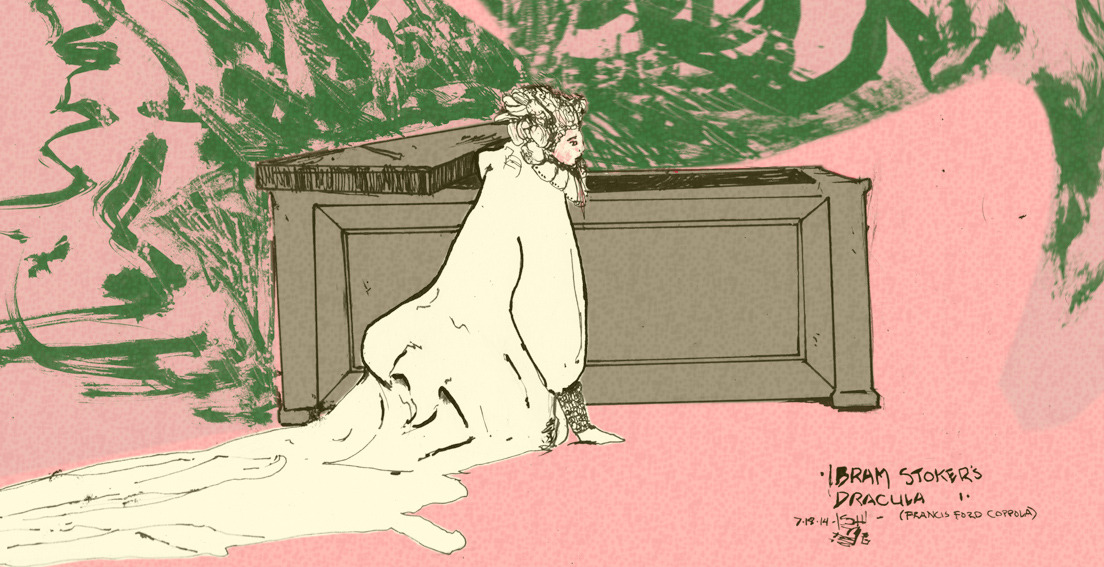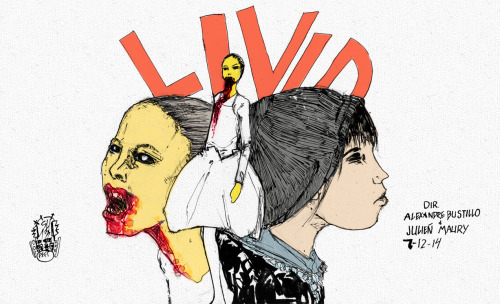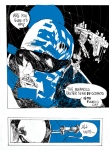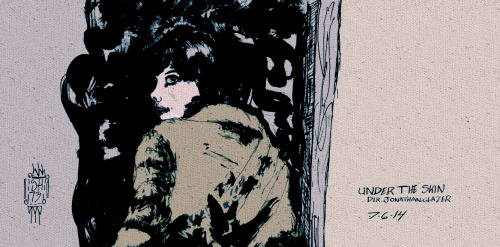Julia Gfrörer’s “Phosphorous” opens with a crying young man arriving at a pond. His first words, which appear before him are “fuck you, fuck you dad”. And thus begins a short but dense unpacking and subversion of the traditional representations of masculinity in patriarchal society. It is in this deconstruction where beautiful horror streams in, and Gfrörer is able to construct a piece of sublime weight.
Male tears are something of a rare bird in the dominant fiction of our culture, and so upon their materialization you do kind of have to lap them up with a particular fervent earnestness. In Julia Gfrörer’s “Phosphorous”: our starting point is a man in the woods. This stone chucking man, with his pack of things, cuts something of an archetype of the self-sufficient capable man under whose foot nature bends in hierarchical accordance. But that image is mixed in with tears and volatile emotions. His principle struggle between himself and his father, which he expresses through sexualized obscenities, is presented here as a kind of hysteria. This is the son who cock in hand, wishes to assert his virility over his father, and in so doing ascend into adult alpha-malehood. It is a primordial struggle between father and son—and by mixing that with tears, we are presented the image of masculinity as rooted in an emotional struggle and perhaps not entirely within control of its own faculties. It is not without importance that he has left his father, to come to this pond to and meet his obscene repressed dark mother; and it is not without mirrored appropriateness that the interactions between the two will also be sexual in its nature.
What is interesting with the man’s relationship to the woman in the pond is that rather than following the mold of the dominant patriarchal cultural representations, wherein it is the woman who is regressed by sex—here we see the man turned into the cooing monosyllabic child face of ecstasy. While the former is not a truth, but a cliche, Gfrörer has inverted it al the same—and even though the woman in the pond is constantly shown beneath the man, she is in complete control of him from that position. She has him by the balls. This is still a depiction of masculinity—but there is a recontextualization from father-daughter imagery to mother-son imagery. We see this repeatedly in the comic as the woman cradles and comforts the man throughout the entire sexual experience, even going as far as to recreate the Pieta on the shores of the pond. Which now is a beautiful blasphemy of the dead white Christ and the black Virgin Mother now post incestual coitus. The transformation of the woman in the swamp from monstrous other to woman to virgin death mother encompasses a cycle that recalls very easily the xenomorphs of the Alien films.
It wouldn’t be inappropriate to introduce Alien(1979) here into the conversation because a lot of the dramatic forces which made that one of the great works of horror of the 20th century, are also at play here. In Alien it is the notion that men can be overpowered, violated, and impregnated by the monstrous feminine that baselines a lot of the squeamishness of both Giger’s designs and Scott’s atmosphere of overriding dread. As well, we also deal with the irrationality of men in Alien; Over and over again, the men of the movie make emotionally charged and altogether disastrous decisions(the most prominent of which is to bring Kane into the ship against strict quarantine guidelines, and Ripley’s stern direction not to). In this way there are two mothers at play in Alien, Ripley, and the xenomorph—and both are disregarded by men to the peril of all of those around them. So there’s a resonance in terms of the forces at play between Alien and “Phosphorous”, and while these themes are in more places than Alien—I think that’s probably the clearest, best example of what we’re talking about here—and I bring it up, because the monster at the bottom of the pond in “Phosphorous” is operationally very similar to Giger and Scott’s xenomorph.
There is a mirror here between the young man approaching the strange glow in the pond, and Kane in Alien approaching the egg which contains the facehugger. In both instances, male bravado and curiosity has led it into the clutches of a female trap. The other main comparison here is obviously that the xenomorph represents both sex and death. The woman in the pond operates along a similar axis, and though she doesn’t kill the young man, she is as interested in his life’s breath as she is his semen.
Shifting focus onto the woman in the pond: we see that even though, as mentioned previously, she is shown below the man at almost all times (there are in fact, only three panels where she is compositionally drawn above the man), the way that she touches and talks to the man is never subservient. I think one of the most interesting sequences in “Phosphorous” is when she grabs the man’s penis and begins manipulating it curiously. Even though fundamentally we can recognize this as a hand job—the way that it has been contextualized is with the penis as a foreign object—the penis is objectified here; both by being the disembodied focus of the hands in the panel, but also in the way that it supersedes the man in terms of the importance it takes in their interaction. She orders him to show her how it works, and he immediately complies to her authority, and begins, tears in eyes, to masturbate.
As she pulls him under water the imagery turns from that of purely sex, to also that of death as we see both semen and life breath being extracted from the boy. This idea of the female extracting sex and then bringing death is all through nature (and for what it’s worth it is also how the xenomorph functions). It is an intensely erotic idea because it plays with our ideas of sex as something of a life force that is done to reproduce ourselves continuously through time in opposition to the finality of death; so to present sex also as the cessation of one’s life, and rather instead, present it as a reminder of death creates taboo. And through the transgression of the taboo, we get the energy of the obscenity from which we feel the push and pull of our gaze throughout this work.
There is something else happening here and that is sex as connection. The young man in his disconnect from his father, is here, whether explicit to his knowledge or not, to connect with both his mother and his repressed childhood. He is having this experience to break down the walls between his present identity, and these separated refractions of self spread throughout his subconsciousness. By introducing death play into the sex, those barriers are even further eroded, as identity weakens alongside life’s waning assertion. This gap allows for the identity of the other, in this case the dark mother, to flood in and fill—In doing so, the man becomes the boy becomes the fetus becomes the mother. This regression becomes complete once he has died. Two circles rotating in opposite directions, meeting at a singular incestual point joined through the mirror.
It is the culmination of these densely layered motions and counter motions which give “Phosphorous” the mesmerizing strength that it has. It is only a six page comic nestled at the back of Gfrörer’s Black Light collection, but it follows you away from the page in a way that few comics being made currently by anyone else can claim to. I actually showed this comic to someone at my day job, and they were completely transfixed. It happens quickly, but it happens powerfully, and the work as a whole is quintessentially what I mean when I talk about my own interests in the horrible beautiful. For me Gfrörer’s work is absolutely at the forefront of comics being made today, and however poorly they translate into my ability to write about them, these are the kinds of comics and creators which should be struggled with, not the regressive toy shit that dominates the weekly controversies. You can put Julia’s work up against other top works in other mediums happening right now, and it can absolutely trump them. It’s extremely exciting for comics.







